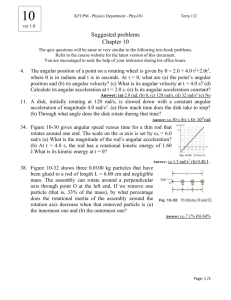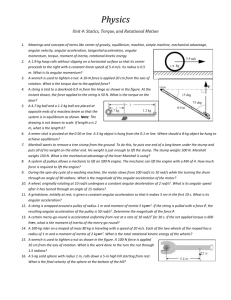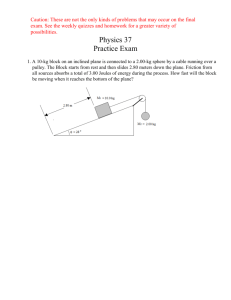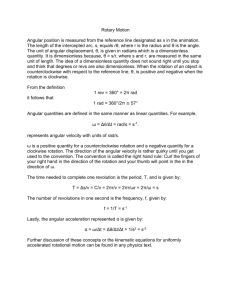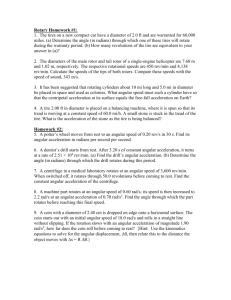MIT Rotating Rigid Bodies, Inertia, and Axis Theorems – Practice
advertisement
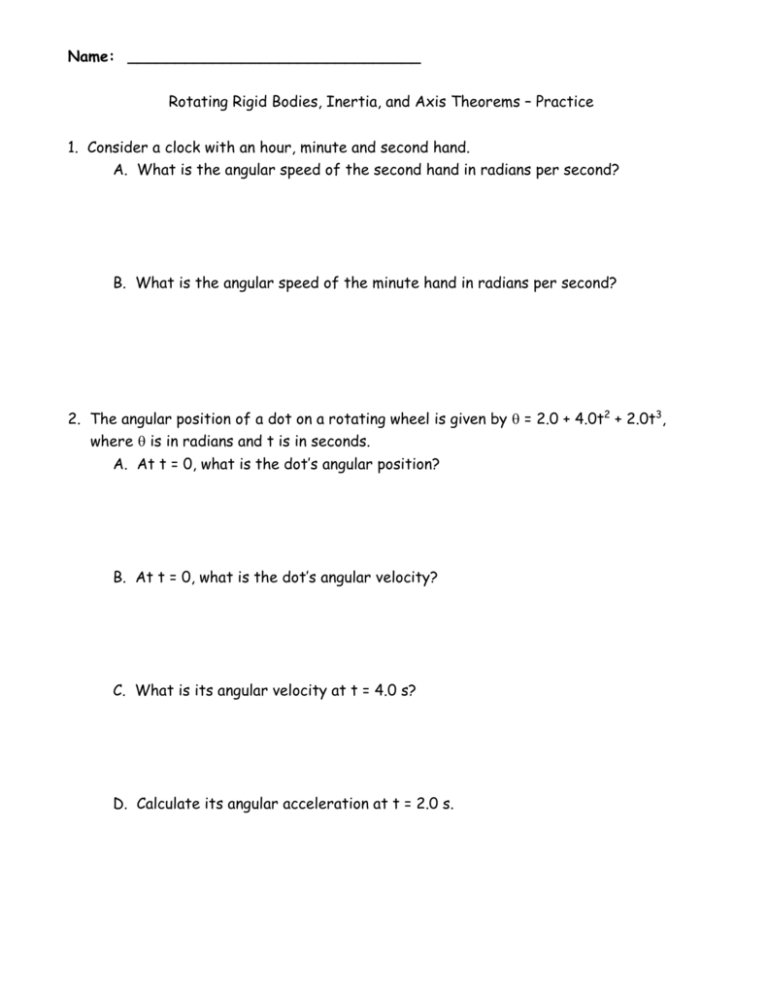
Name: _______________________________ Rotating Rigid Bodies, Inertia, and Axis Theorems – Practice 1. Consider a clock with an hour, minute and second hand. A. What is the angular speed of the second hand in radians per second? B. What is the angular speed of the minute hand in radians per second? 2. The angular position of a dot on a rotating wheel is given by = 2.0 + 4.0t2 + 2.0t3, where is in radians and t is in seconds. A. At t = 0, what is the dot’s angular position? B. At t = 0, what is the dot’s angular velocity? C. What is its angular velocity at t = 4.0 s? D. Calculate its angular acceleration at t = 2.0 s. 3. A wheel has eight equally spaced spokes and a radius of 30 cm. It is mounted on a fixed axle and is spinning at 2.5 rev/s. You want to shoot a 20 cm-long arrow parallel to this axle and through the wheel without hitting any of the spokes. Assume that the arrow and the spokes are very thin. A. What is the minimum speed the arrow must have? B. Does it matter where between the axle and rim of the wheel you aim? If so, what is the best location? 4. A flywheel turns through 40 rev as it slows from an angular speed of 1.5 rad/s to a stop. A. Assuming a constant angular acceleration, find the time for it to come to rest. B. What is its angular acceleration? C. How much time is required for it to complete the first 20 of the 40 revolutions? 5. A merry-go-round rotates from rest with an angular acceleration of 1.50 rad/s2. How long does it take to rotate through: A. the first 2.00 rev? B. the next 2.00 rev? 6. Rotating Earth A. What is the angular speed about the polar axis of Essex High School at a latitude 44.50° N? B. What is the linear speed v of Essex High School? REarth = 6.4 x 106 m C. What are and v for a point on the equator? 7. A gyroscope flywheel of radius 2.83 cm is accelerated from rest at 14.2 rad/s2 until its angular speed is 2760 rev/min. A. What is the tangential acceleration of a point on the rim of the flywheel during this spin-up process? B. What is the radial acceleration of this point when the flywheel is spinning at full speed? C. Through what distance does a point on the rim move during the spin-up? 8. Rotational Kinetic Energy 1 I2) of the Sun. (Remember that 2 2 if you approximate the Sun as a solid sphere then the rotational inertia I = 5 2 30 3 MR .) TSun = 26 Days M = 2 x 10 kg R = 700 x 10 km A. Calculate the rotational kinetic energy (K = B. Calculate the rotational kinetic energy of the Earth? TEarth = 1 day M = 6 x 1024 kg R = 6.4 x 103 km 9. A pulsar is a rapidly rotating neutron star that emits a radio beam the way a lighthouse emits a light beam. We receive a radio pulse for each rotation of the star. The period T of rotation is found by measuring the time between pulses. The pulsar in the Crab nebula has a period of rotation of T = 0.033 s in 2011 that is increasing at the rate of 1.26 × 10-5 s/y. (1 y = 3.16 x 107 s) A. What is the pulsar's angular acceleration ? B. If is constant, how many years from now will the pulsar stop rotating? C. The pulsar originated in a supernova explosion seen in the year 1054. Assuming constant , find the initial T. Solutions: 1. A. 0.105 rad/s B. 1.75 x 10-3 rad/s 2. A. 2.0 rad B. 0 rad/s C. 130 rad/s D 32 rad/s2 3. A. 4.0 m/s B. No, it does not matter. 4. A. 3.4 x 102 s B. -4.5 x 10-3 rad/s2 C. 98 s 5. A. 4.09 s B. 1.70 s 6. A. 7.27 x 10-5 rad/s B. 3.3 x 102 m/s C. 7.27 x 10-5 rad/s and 4.7 x 102 m/s 7. A. 0.402 m/s2 B. 2.36 x 103 m/s2 C. 83.2 m 8. A. 1.5 x 1036 J B. 2.6 x 1029 J 9. A. -2.3 x 10-9 rad/s2 B. 8.3 x 1010 s (= 2.6 x 103 y) C. 0.24 s




